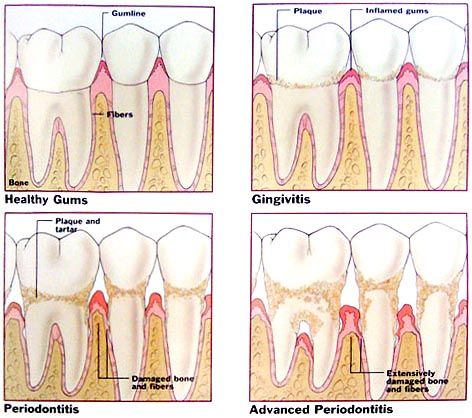
Gum Disease
Periodontal disease, or gum disease, is an infection of the tissues that support your teeth, and the number one cause of tooth loss. Regular dental checkups are essential to the diagnosis because it is possible to have periodontal disease and seemingly no warning signs. Periodontal disease is usually pain free until the late stages of progression.
The main cause of gum disease is plaque buildup. When plaque is not regularly removed (by brushing, flossing, and regular dental cleanings), it damages the gums.
There are 2 major types of gum disease. Gingivitis is a milder form of periodontal disease that only affects the gums. The patient may experience red, swollen gums and even bleeding gums. With good oral hygiene (brushing and flossing), gingivitis can be treated and reversed. However if gingivitis is allowed to progress, it may lead to more serious, destructive forms of periodontal disease called periodontitis. Periodontitis affects not only the gums, but the attachment fibers and bone that surround the teeth and anchor them in place. As these tissues become affected, the overall support of the tooth is compromised and at the severe stage can result in loss of the tooth.
Treatment methods depend upon the type of disease and how far the condition has progressed. Once treated, good oral hygiene at home is essential to help keep periodontal disease from becoming worse or recurring. You don't have to lose teeth to periodontal disease. Brush, clean between your teeth, eat a balanced diet, and schedule regular dental visits for a lifetime of healthy gums and healthy smiles.

- Tobacco use
- Diabetes and other systemic diseases
- Some types of medication such as steroids, some types
of anti-epilepsy drugs, cancer therapy drugs, some calcium
channel blockers and oral contraceptives - Ill-fitting bridges
- Crooked teeth
- Defective fillings
- Pregnancy or use of oral contraceptives
- Gums that bleed easily
- Red, swollen, sore gums
- Gums that have pulled away from the teeth
- Persistent bad breath or bad taste
- Permanent teeth that are loose or separating
- Any change in the way your teeth fit together when you bite
- Any change in the fit of partial dentures
Some factors increase the risk of developing periodontal disease:
Several warning signs that can signal a problem: